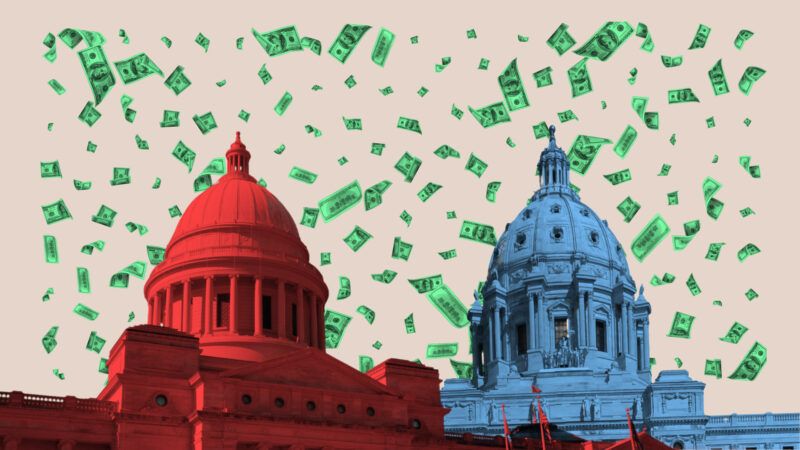Biden Administration Quietly Extended the Unnecessary COVID Bailout for States and Local Governments
Republican senators say the change is "mind-bending and deeply concerning."

When the federal government distributed $350 billion to states and localities as part of a 2022 pandemic aid bill, the rules were clear: find ways to spend the money by the end of 2024 or it would recouped by the feds.
But the Biden administration quietly changed those rules in late 2023 to give state and local governments more time to spend their American Rescue Plan Act (ARPA) funds. Critics say it's a change that could transform an already wasteful and unnecessary bailout into an open-ended slush fund for those governments.
That change, which was announced in the Federal Register (which documents the doings of executive branch agencies) in November but otherwise given little fanfare, will give state and local governments until the end of 2026 to decide how to spend their remaining ARPA bailout funds. Under the terms Congress set out in ARPA, those governments had to "obligate" those funds—in other words, attach them to a specific project—by the end of this year, even though they were given until 2026 to actually spend the money.
Officially, the Treasury Department is "amending the definition of 'obligation' to provide additional flexibility to recipients," according to the Federal Register. While state and local governments must still return unobligated funds by the end of this year, the new definition of "obligation" provides several ways for the recipients to hoard their federal bailout funds without committing them to specific projects.
"The outcome is mind-bending and deeply concerning," a group of six Republican senators wrote in a letter to the Treasury Department in mid-December, formally objecting to the rule change. The "new definition—permitting recipients to make future agreements to spend [program] funds in 2025 and 2026—stretches the word 'obligation' outside of any plain use of English," they added.
Unless the Treasury Department rescinds the new rule, those six lawmakers—Sens. Mike Braun (R–Ind.), Ron Johnson (R–Wis.), Mike Lee (R–Utah), Roger Marshall (R–Kan.), Eric Schmitt (R–Mo.), and Rick Scott (R–Fla.)—pledged to introduce a resolution invoking the Congressional Review Act to block the new rules.
The November extension came just a month after a Government Accountability Office (GAO) report found that states (including Washington, D.C.) had spent just 45 percent of the funding they had received through ARPA, while local governments have spent just 38 percent of their COVID bailout funds. As Reason reported at the time, that report seemed to underline how unnecessary the bailout was in the first place.
Other studies have pointed toward a similar conclusion. In a National Bureau of Economic Research working paper published in June 2022, a trio of researchers found that pandemic-era aid distributed to state and local governments had cost taxpayers about $855,000 per job saved. The stimulus spending had only "a modest impact on government employment and has not translated into detectable gains for private businesses or for states' overall economic recoveries," they concluded.
Many of the projects already funded through ARPA seem to have little to do with pandemic relief. Some governments used the funds to give bonuses to public workers. Iowa used $12.5 million of its cut to build a new baseball stadium near the Field of Dreams movie set. Michigan blew $25 million on a travel marketing campaign.
According to a recent review of ARPA spending by the Economic Policy Innovation Center (EPIC), a conservative group, state and local governments have approved $185 million in bailout funds for golf courses, $400 million to upgrade swimming pools, and $34 million for tennis and pickleball courts. All essential pandemic-recovery efforts, of course!
The rule change issued in November means state and local governments will have "more time to select boondoggles and handouts," wrote David Ditch, a budget policy analyst at the conservative Heritage Foundation. Citing EPIC's research, Ditch says the rule change could end up costing "a staggering $1,200 per household."
It's also worth keeping in mind that the federal government considers the pandemic to be over. The federal public health emergency for COVID-19 ended in May. But why should that stop the federal gravy train from rolling along?
Show Comments (29)